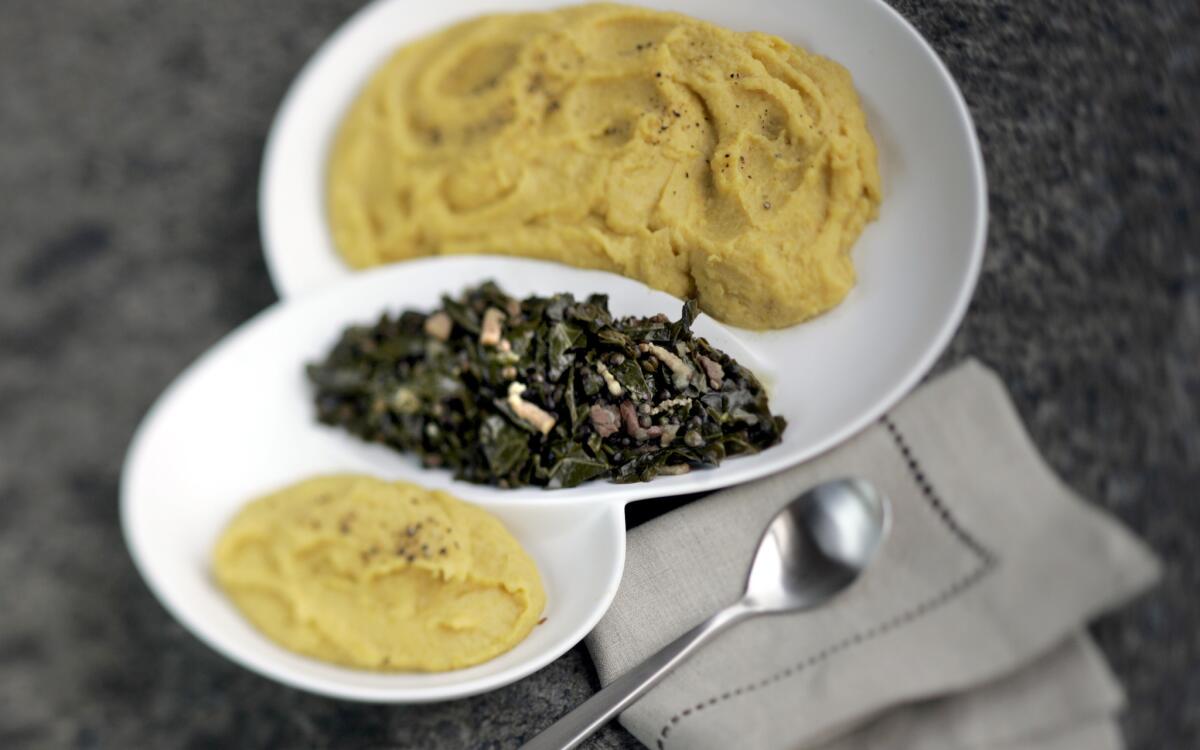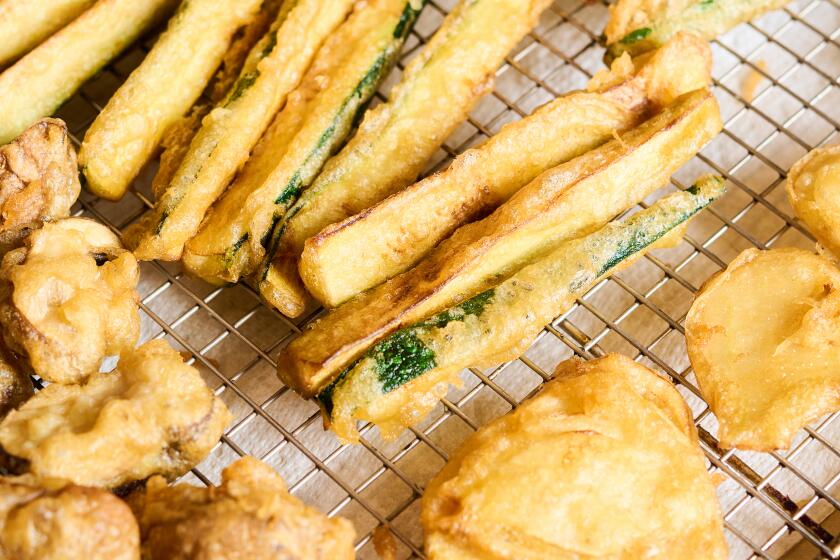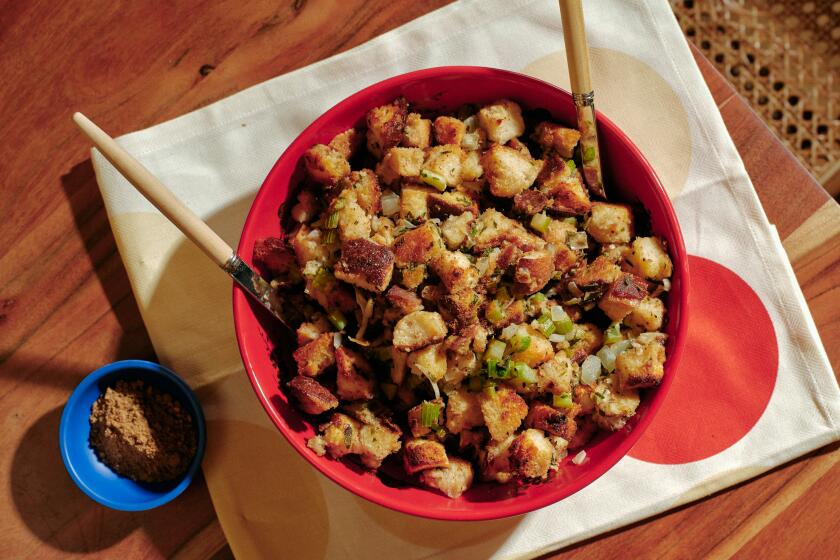Collard greens and lentils

- Share via
It’s the old parlor game: “If you could eat dinner with anyone you wanted, whom would it be?” That may be fun for some, but for those who love to cook, wouldn’t a more kitchen-centric twist be even better? Wouldn’t you rather fantasize about whom you would like to get to help you fix that meal?
Particularly at Thanksgiving, the most food-centered of American holidays, who doesn’t dream about having a great cook drop by to lend a hand?
Even the greatest chefs are not all created equal. Each excels at a slightly different aspect of cooking. So, with a menu as diverse as Thanksgiving’s, what you really want is an entire collection of great chefs -- a kind of Turkey Day Dream Team.
The trick is in identifying the talent and then matching it up with a specific course. For example, who knows more about cooking poultry than Judy Rodgers, who built San Francisco’s Zuni Cafe largely on the basis of a wonderful roast chicken? On the other hand, for a bit of sheer luxury who better to turn to than Daniel Boulud, chef at Manhattan’s four-star Daniel?
Michel Richard, chef at Washington, D.C.’s Citronelle, is a genius at putting a creative twist on familiar flavors, so he can do the vegetables -- no boring old steamed broccoli from him. The list goes on: The French Laundry’s Thomas Keller has built a career on elegant small bites to start the meal; he’ll do appetizers. Lydia Shire, chef at Boston’s Excelsior, will take charge of the cranberries -- after all, they’re grown in her backyard. And for a glamorous, over-the-top dessert, there’s only one choice: Spago pastry chef Sherry Yard.
The only question now is: Whom would we choose to clean up?
The hors d’oeuvres
Anyone who has eaten at the French Laundry or Per Se knows that Thomas Keller is fascinated by appetizers. Dinner at either of those restaurants begins with a parade of them (indeed, given the size of Keller’s portions, it could be argued that they make up the entire meal).
Thanksgiving is no different. From the earliest holidays he can remember, dinner started with little bites. Of course, back then the menu was slightly different than today.
“Ants on a log,” he remembers. “That’s one I remember: Take celery sticks and mix up some cottage cheese with salt and pepper and parsley or chives and put it in the center. Sprinkle raisins on top. That’s ants on a log. My mom fixed it every Thanksgiving.”
They’d be accompanied by a hit parade of ‘60s favorites: “Always a crudite plate with radishes, cauliflower, broccoli and green goddess dip, or her favorite, which was onion dip. Oh, and stuffed mushrooms, the kind with bread crumbs on top that you’d put under the broiler. And canned artichoke hearts.”
Today, appetizers are still an important part of the meal, though they’re a bit more refined: marinated olives and jumbo macadamia nuts and a big tin of caviar and some smoked salmon. And different kinds of spreads spooned onto toasts or crackers. “But we’re so sophisticated now,” Keller quips, “we use Carr’s water crackers. We always had Ritz when I was growing up.”
Despite the menus’ obvious differences, they share the same idea. The point of an appetizer should be not only to pique the appetite, but to set the meal in motion by getting people involved with eating. “It’s about interaction with the food,” Keller says.
A good example is the shrimp with avocado salsa, each piece set on its own fork. It’s not fussy, but fun. “I love serving things that people can eat with their fingers,” he says. The shrimp, which he uses as a passed appetizer at parties in the French Laundry’s garden, has a sophisticated presentation, but it couldn’t be easier to put together.
The salmon rillettes, a favorite first course at Keller’s Bouchon bistros, in Napa Valley and Las Vegas, is nearly rustic in its preparation and simple in its presentation (well, at least for Keller). The surprising, almost herbal, flavor undertones and a combination of coarse and creamy textures come from mixing finely diced smoked salmon and silky chunks of the steamed fish (and, of course, a satisfying amount of butter). It can be made ahead and will even improve for several days, ripened in the refrigerator, sealed under a cap of ... what else? More butter.
Divide the appetizers into smaller portions and position them at different points in the dining room, and you’ll encourage mingling, getting the guests to interact with one another while they interact with their food. As Keller says, “Thanksgiving is about getting together with family and people you love and having a wonderful time.”
The turkey
If you should happen to run into Judy Rodgers driving around Berkeley on Thanksgiving Day, don’t be surprised at the large bundle in her lap. It’s her turkey. Rodgers and her husband celebrate the holiday every year with her sister-in-law across town, and even on this rare day off from the restaurant, the consummate roaster can’t bring herself to give up the reins. “I know my oven and I don’t know hers,” Rodgers says. So she roasts the turkey in advance. Then she lays bath towels in her lap and cradles the cooked bird in its roasting pan for the drive over.
As you might expect, Rodgers has definite ideas about what makes a great bird.
In the first place, gender matters. “I like toms, not those big fat-breasted hens,” she says. “They have better flavor, and they cook more evenly. You don’t have those big Hoover Dam-sized breasts that you need to cook while everything else is getting completely overcooked.”
Rodgers is an advocate of salting meat well in advance and letting it sit to season through. Because a turkey is so large, that method won’t work, so she uses a brine. This means she can’t stuff it or make gravy; they would come out too salty. But the absence of gravy doesn’t bother her -- she says her turkey turns out so moist it doesn’t need any.
Never a big fan of stuffing, Rodgers instead makes a version of the same bread salad she serves with her famous roast chicken. “Doing it this way, you get such a mixture of textures and flavors,” she says. “There’s some crisp and some soft. And I really like the combination of dried cranberries and pecans.”
According to Rodgers, two of the most important steps in roasting a turkey are often overlooked. The first is what she calls “tempering” the bird: letting it sit at room temperature after taking it out of the refrigerator and before roasting it. This lets it cook evenly -- otherwise, the deep joints where the thighs join the carcass will hold the chill longer and may still be bloody even when the breast is nearing dryness.
The other is letting the turkey rest at room temperature after the roasting. This allows the muscle fibers to reabsorb some of the moisture that has been squeezed toward the center during the cooking. It is the key to both a moist bird and one that has flesh firm enough to carve easily.
And it fits easily into the Thanksgiving schedule, even one like hers that requires travel. “Actually, I’ve found that the trip from our house to my sister’s is just about the perfect resting time,” Rodgers says. “It’s about a 20-minute drive and by the time everything gets loaded and unloaded, the turkey is perfect.”
The potatoes
Daniel Boulud has nothing against turkey. The chef at New York’s Daniel (and several other restaurants) just thinks it lacks a little, you might say, luxury. Not in the sense of fancy ingredients, but in the old-fashioned way. In other words, “something very silky, buttery, tasty like that,” he says. “Something to keep the moisture around it.”
This doesn’t mean serving the bird with foie gras. Perfectly humble ingredients work much better. One of Boulud’s favorites is a sweet potato-winter squash puree. Caramelized apples and bananas give it silkiness when it’s put through the food processor, and cinnamon, cloves, allspice, fennel seed and star anise spice it up. “This is one way of getting a complexity of flavor, combining things that go well with turkey in a way that you can’t do unless you puree them,” he says.
Mushrooms can also supply that luxurious quality. “What kind of mushroom might vary, but it’s always some kind of fricassee,” says Boulud. “Good wild mushrooms, butter and olive oil, a little rosemary and garlic. I always add a little bit of toasted bread crumbs or maybe just a little bit of flour to dry them out a little bit and to absorb the juices.”
Even better, you can layer them into a potato gratin and bake them slowly, liberally bathed in cream. This way all of the disparate elements unite and form a harmonic “third flavor.” This gratin tastes almost as if someone slipped in some black truffles. There aren’t any, but you could certainly use them if you happen to have some lying around.
There’s certainly nothing wrong with that kind of luxury, either.
The cranberries
When Lydia Shire was growing up in Brookline, Mass., the highlight of the cooking year was Thanksgiving. Today she’s chef at Boston’s Excelsior and Locke-Ober restaurants, but back then she was her father’s kitchen helper. “From the time I was little I was always helping him cook,” she says. “I couldn’t stay out of the kitchen.”
Shire’s father died when she was 15, but she still makes the cranberry jelly that he’d adapted from a recipe in an old Fannie Farmer cookbook. This is cranberry jelly as God intended it to be and to taste it is to realize how far all those others have fallen (even if they do look cute right out of the can). It sets with a deceptively delicate jiggle that gives no hint to its deep flavor or its warm clove-and-cinnamon spice, one of those dishes that is almost impossible to stop eating.
It’s incredibly easy to make too -- you just boil cranberries with a packet of sweet spices until the berries soften and thicken and then strain the mixture, add sugar and cook it briefly again.
Even today, Shire says, “I have to have that flavor. I can’t go through that day without having certain flavors in my mouth because it wouldn’t be Thanksgiving.” And helping out in the kitchen will be Shire’s 14 1/2 -year-old son, Alex. “He’s going to be a cook, you know,” Shire says. “I’m absolutely sure of it.”
The vegetable sides
At his 55th birthday party last year, cooked by such chefs as Keller and Le Bernardin’s Eric Ripert (and attended by others, including Boulud and Pierre Gagnaire), Michel Richard, whose jolly demeanor masks a deeply competitive nature, blew everyone away with a postmodern rendition of ratatouille: each vegetable reduced to its flavor essence, set into a firm but soft jelly and presented in a sculptural mix of cubes the size of playing dice.
Richard, chef at Citronelle in Washington, D.C., is one of the country’s most creative and playful chefs, even when it comes to the Thanksgiving vegetable course -- something usually tacked on as an afterthought.
Thanksgiving, as it turns out, is Richard’s favorite holiday. It’s the most French after all -- centered around the table, he explains. “Thanksgiving I love,” he says, “because I don’t have to worry about buying gifts; I don’t need to go to Mass; I don’t need to do anything but sit down at the table at 4 o’clock with my family and my friends and eat good food, drink good wine and then go outside and drink Armagnac and smoke cigars.”
While the deconstructed ratatouille may be a bit extreme for a family dinner, Richard did come up with two winners. In his stuffed Savoy cabbage, the whole leaves -- pale green and silken after long, gentle cooking -- are wrapped around duxelles, sauteed chopped mushrooms given an extra layer of nutty complexity by a hint of curry powder.
And it would be almost impossible not to love the very Franco-American combination of long-cooked earthy Southern collard greens and the meaty green lentils from Le Puy, France. The way these seemingly unrelated ingredients play off each other is astonishing (and delicious).
For his Thanksgiving at home, Richard’s turkey will be a simple roast bird, albeit with a French twist: a stuffing made with chestnuts and boudin blanc. “My wife used to accept a very thick French accent, but now it’s only a little French accent,” he says. “My family likes a traditional Thanksgiving dinner, but there is still a mixture of the two countries.”
The dessert
Sherry Yard’s Thanksgivings growing up in Brooklyn sound a little like “I Love Lucy.” First of all, her mother didn’t cook. Her dad did, but he had unconventional notions of what to serve. For Thanksgiving, she remembers, “he’d set up a gas barbecue out in the backyard and go out in the cold and do steaks or kielbasa sausage, anything but turkey.”
Then there was the famous episode with the creamed corn. “My mother never opened the cans and emptied them into a pot; she just put them on a baking sheet and stuck it in the oven,” she says. One Thanksgiving, disaster struck: “The oven blew up and we had creamed corn everywhere. It’s just lucky nobody got hit by the can.”
So it’s no surprise that Yard’s notions of a perfect Thanksgiving dessert are out of the ordinary. If she could have it her way, she’d eat chocolate cream pie, or cookies. She does love pumpkin, but, of course, has very definite opinions about how it should be treated. “A lot of Thanksgiving food tends to be a little bit on the sweet side already, so I don’t like to make anything too sweet,” she says. “And I like to use brown sugar, or honey, because they don’t have the same monotone sweetness that sugar does.”
In fact, her pumpkin dessert is a showstopper, kind of a pumpkin pie topped with a surprise. But it’s not really a pie; it’s a layered torte, built in a springform pan on top of a pastry crust. Pumpkin custard comes next, then a layer of whipped cream enriched with creme fraiche and flavored maple sugar, and for the crowning glory, a caramely pumpkin chiboust -- like a cold souffle. The chiboust, which has a slightly bitter note on its own, sets off the sweet pumpkin custard beautifully.
It may be a bit of a project, but actually it’s not as complicated as it seems (you can even make it a day or two ahead, when things are a little calmer). And the results are well worth the effort.
After all, this is Thanksgiving, and if you can’t fantasize about a dreamy dessert now, when can you?
Heat the oven to 250 degrees. Heat the olive oil in a large Dutch oven or ovenproof pot and saute the onion over medium heat until it becomes translucent and begins to soften, about 3 minutes. Add the bacon and cook until it softens, about 5 minutes. Remove the pot from the heat and remove any excess oil by patting the bacon and onion with a paper towel.
Return the pot to the heat and add half the greens. This will fill the pot, but as you cook, stirring frequently, the leaves will wilt and shrink. When there is enough room, add the remaining greens and the chicken stock. Stir to mix evenly.
Cover the pot and place it in the oven to cook until the greens are well stewed and deeply fragrant, about 1 1/2 hours.
Add the lentils, stir, cover and return the pot to the oven until the lentils are tender but still a little chewy, about 40 to 45 minutes.
Season to taste with salt and pepper and stir in 1 tablespoon of balsamic vinegar. Taste and add a little more vinegar if necessary. Serve immediately.
Get our Cooking newsletter.
Your roundup of inspiring recipes and kitchen tricks.
You may occasionally receive promotional content from the Los Angeles Times.
















